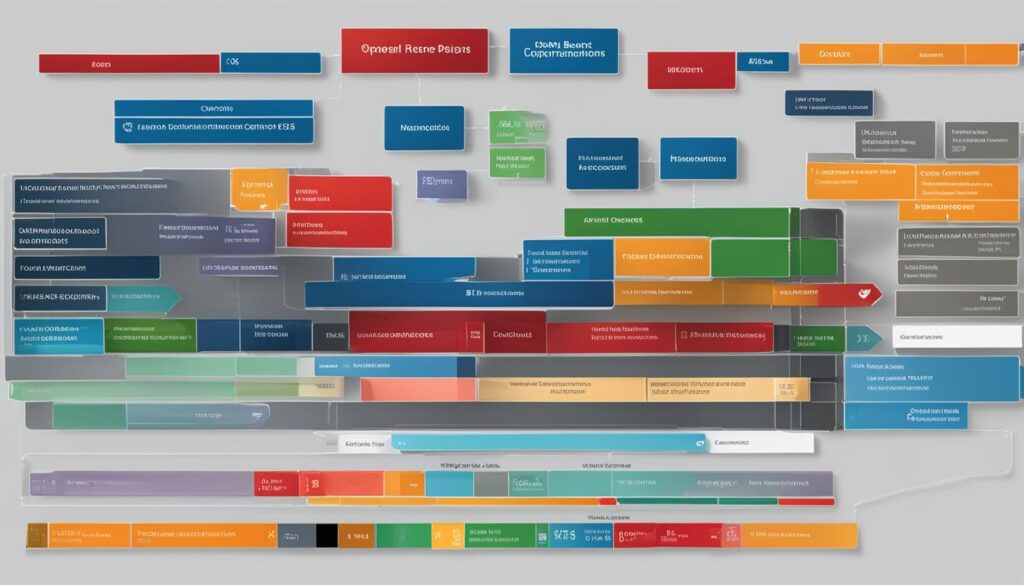Central bank policies have a significant impact on financial stability and economic growth. This guide aims to provide a comprehensive understanding of the tools and principles employed by central banks to shape the economy.
Monetary policy and fiscal policy are two key components of central bank policies. Monetary policy focuses on managing interest rates, inflation targeting, and exchange rates. Fiscal policy involves government spending and taxation.
Throughout this guide, we will delve into the intricacies of these policies, exploring concepts such as quantitative easing, policy rates, open market operations, and reserve requirements.
By gaining a deeper understanding of central bank policies, readers will be better equipped to comprehend how these policies impact the economy and contribute to financial stability. Stay tuned for the next sections, where we will explore each aspect in detail, including the challenges and risks associated with central bank policies.
What Are Central Bank Policies?
Central bank policies refer to the strategies and actions implemented by central banks to control and regulate the economy. This includes both monetary policy, which focuses on managing the money supply and interest rates, and fiscal policy, which involves government spending and taxation. Central bank policies are designed to maintain price stability, promote economic growth, and ensure financial stability.
Monetary policy is primarily concerned with managing the money supply and interest rates to influence borrowing costs and stimulate or slow down economic activity. It involves tools such as adjusting policy rates, conducting open market operations, and implementing quantitative easing measures during times of financial crisis. By influencing interest rates, central banks can impact investment decisions, consumption patterns, and overall economic growth.
Fiscal policy, on the other hand, involves the use of government spending and taxation to influence the economy. Central banks work in conjunction with fiscal authorities to strike a balance between spending and revenue collection. Fiscal policy can be expansionary, aimed at stimulating economic growth through increased government spending, or contractionary, intended to reduce inflationary pressures by decreasing expenditure. Through fiscal policy, central banks can affect aggregate demand, employment levels, and inflation rates.
Table: Key Differences Between Monetary and Fiscal Policy
| Monetary Policy | Fiscal Policy |
|---|---|
| Managed by central banks | Managed by governments |
| Focuses on managing money supply and interest rates | Focuses on government spending and taxation |
| Uses tools like policy rates, open market operations, and quantitative easing | Uses tools like government spending and taxation policies |
| Affects borrowing costs, investment decisions, and economic activity | Affects aggregate demand, employment levels, and inflation rates |
| Implemented to control inflation, economic growth, and financial stability | Implemented to manage economic activity and stabilize the economy |
The Role of Monetary Policy
Monetary policy plays a pivotal role in the overall functioning and management of an economy. It encompasses various tools and strategies implemented by central banks to control the money supply, interest rates, and exchange rates.
One of the key components of monetary policy is the manipulation of interest rates. Central banks adjust interest rates to influence borrowing costs, thereby stimulating or slowing down economic activity. By lowering interest rates, central banks aim to encourage borrowing and investment, which can stimulate economic growth. Conversely, raising interest rates can curb borrowing and investment, helping to control inflationary pressures and prevent an overheating economy.
Inflation targeting is another vital aspect of monetary policy. Central banks set specific inflation targets and use available tools to keep inflation within the desired range. By maintaining price stability, central banks can create an environment conducive to sustainable economic growth. When inflation rises above the target, central banks may tighten monetary policy by raising interest rates or implementing other measures to curb spending and reduce demand. Conversely, if inflation falls below the target, central banks may ease monetary policy to stimulate spending and boost demand.
The Role of Quantitative Easing
During times of financial crisis or economic downturn, central banks may also employ unconventional tools such as quantitative easing. Quantitative easing involves the purchase of government bonds or other assets by the central bank, injecting money into the economy and increasing the money supply. This infusion of liquidity aims to stimulate lending and investment, providing a boost to the economy. By purchasing securities, central banks also help to lower long-term interest rates, making borrowing more affordable and encouraging spending and investment.
Exchange rates also fall within the purview of monetary policy. Central banks may intervene in the foreign exchange market to stabilize or influence exchange rates. This can be done through buying or selling currencies to maintain a desired exchange rate level. Exchange rate stability is critical for promoting international trade and ensuring economic stability, as exchange rate fluctuations can impact exports, imports, and overall economic competitiveness.
| Tool | Purpose |
|---|---|
| Interest rates | Influence borrowing costs and economic activity |
| Inflation targeting | Maintain price stability within a specific range |
| Quantitative easing | Inject liquidity into the economy during emergencies |
| Exchange rate management | Stabilize and control exchange rates |
In summary, monetary policy is a multifaceted tool that central banks use to manage interest rates, inflation, and exchange rates. By manipulating these factors, central banks aim to maintain price stability, promote economic growth, and ensure financial stability.
The Role of Fiscal Policy
Fiscal policy is a critical component of central bank policies, working hand in hand with monetary policy to drive economic outcomes. It refers to the use of government spending and taxation to influence the overall economy. By adjusting government expenditures and tax levels, fiscal policy aims to stimulate or slow down economic growth, manage inflation, and ensure a stable fiscal environment.
“Fiscal policy involves the use of government spending and taxation to influence the economy.”
Government spending can stimulate economic growth by enhancing public infrastructure, investing in education and healthcare, and promoting research and development. By increasing government expenditure during periods of economic slowdown, fiscal policy can boost aggregate demand and create jobs, providing a stimulus to the economy. Conversely, during times of inflationary pressures, fiscal policy can be contractionary, reducing government spending and tightening public borrowing to curb excessive spending and stabilize prices.
“Fiscal policy involves balancing government spending and taxation to achieve economic stability and growth.”
Taxation is another key tool used in fiscal policy. By adjusting tax rates, governments can influence household and business consumption and saving patterns. Tax policy can encourage or discourage certain economic activities, such as investment or consumption, depending on the specific objectives set by the central bank and fiscal authorities. Additionally, taxes are a major source of government revenue, and fiscal policy plays a crucial role in ensuring a sustainable budget balance and managing the national debt.
The Role of Fiscal Policy in Times of Crisis
In times of economic crisis, such as a recession or financial instability, fiscal policy becomes even more important. Governments can implement expansionary fiscal policies by increasing government spending and cutting taxes to stimulate economic activity and combat the downturn. These measures aim to boost consumer and business confidence, restore market stability, and revive economic growth. During the global financial crisis of 2008-2009, many countries adopted expansionary fiscal policies to counteract the negative effects of the recession.
| Fiscal Policy Measures | Effect on the Economy |
|---|---|
| Increased government spending | Stimulates economic growth, creates jobs |
| Tax cuts | Increases disposable income, boosts consumer spending |
| Infrastructure projects | Investment in public infrastructure, stimulates construction industry |
However, it is important to balance expansionary fiscal policies with long-term fiscal sustainability. Excessive government spending, coupled with high levels of public debt, can create fiscal imbalances and undermine the stability of the economy. Therefore, fiscal policy decisions need to consider both short-term economic objectives and long-term fiscal sustainability to ensure a balanced and stable fiscal environment.
Impact of Central Bank Policies on the Economy
Central bank policies have a significant impact on the overall economy. Through their tools and interventions, central banks influence key economic variables and shape the trajectory of financial stability and growth. The implementation of monetary and fiscal policies allows central banks to address various economic challenges and steer the economy towards desired outcomes.
One of the primary ways central bank policies impact the economy is through interest rate adjustments. By raising or lowering interest rates, central banks can influence borrowing costs for individuals and businesses. Lowering interest rates stimulates consumption and investment, promoting economic growth. Conversely, increasing interest rates can dampen inflationary pressures and prevent the economy from overheating. These interest rate decisions have far-reaching effects on investment levels, consumer spending, and overall economic activity.
Financial stability is another crucial aspect influenced by central bank policies. Through careful regulation and supervision, central banks strive to maintain the soundness of the financial system. They monitor and mitigate systemic risks to prevent the occurrence of financial crises. Additionally, central banks act as lenders of last resort during times of distress, injecting liquidity into the banking system to ensure its stability. These measures promote confidence in the financial sector and contribute to overall economic stability.
| Impact of Central Bank Policies | Description |
|---|---|
| Economic Growth | Central bank policies can stimulate or restrain economic growth through interest rate adjustments and fiscal measures. |
| Financial Stability | Central banks play a vital role in monitoring and regulating the financial system to prevent excessive risk-taking and maintain stability. |
| Borrowing Costs | Central bank policies influence borrowing costs for individuals and businesses, impacting consumption and investment decisions. |
| Systemic Risk | Through regulation and supervision, central banks mitigate systemic risks and prevent financial crises. |
In conclusion, central bank policies have a profound impact on the economy, encompassing both financial stability and economic growth. By adjusting interest rates, central banks influence borrowing costs and shape investment and consumption decisions. Their regulatory efforts aim to maintain the soundness of the financial system and mitigate systemic risks. Through their continuous monitoring and policy adjustments, central banks strive to promote a stable and prosperous economic environment.
Key Policy Tools Used by Central Banks

Central banks employ a range of policy tools to implement their strategies and achieve their objectives. These tools include the policy rate, open market operations, and reserve requirements. Each of these tools plays a crucial role in shaping the economy and influencing financial conditions.
The Policy Rate
The policy rate, also known as the benchmark interest rate, is a key tool used by central banks to control borrowing costs and stimulate or slow down economic activity. When the central bank increases the policy rate, it becomes more expensive for commercial banks to borrow money from the central bank. This increase in borrowing costs tends to reduce lending and investment, which can help to cool down an overheating economy. Conversely, when the central bank decreases the policy rate, it becomes cheaper for banks to borrow, encouraging lending and investment and stimulating economic growth.
Open Market Operations
Open market operations refer to the buying and selling of government securities by the central bank. By conducting open market operations, central banks can influence the money supply and interest rates in the economy. When the central bank wants to decrease the money supply and tighten financial conditions, it sells government securities to commercial banks, reducing their reserves and making money scarcer. Conversely, when the central bank wants to increase the money supply and loosen financial conditions, it buys government securities from commercial banks, injecting liquidity into the system.
Reserve Requirements
Reserve requirements are regulations that determine the minimum amount of deposits commercial banks must hold as reserves with the central bank. By adjusting these requirements, central banks can influence the amount of money that commercial banks can lend. When the central bank increases reserve requirements, it reduces the amount of money available for lending, potentially leading to higher borrowing costs and slower economic activity. Conversely, when the central bank decreases reserve requirements, it increases the amount of money available for lending, making borrowing cheaper and stimulating economic growth.
| Policy Tool | Description | Impact |
|---|---|---|
| Policy Rate | The benchmark interest rate set by the central bank. | Controls borrowing costs and influences economic activity. |
| Open Market Operations | The buying and selling of government securities by the central bank. | Controls the money supply and interest rates in the economy. |
| Reserve Requirements | Regulations determining the minimum amount of reserves held by commercial banks. | Influences the amount of money available for lending. |
These policy tools, used in combination with other central bank policies, enable central banks to manage economic conditions, promote financial stability, and support sustainable economic growth.
Central Banks and Financial Stability

Central banks have a crucial role in ensuring financial stability. They serve as guardians of the financial system, monitoring and regulating banks and other financial institutions to prevent excessive risk-taking and maintain the overall soundness of the system. Through their policies and interventions, central banks aim to safeguard the stability and integrity of the financial sector.
One of the key responsibilities of central banks is to act as a lender of last resort during periods of financial crises. This means that they provide liquidity to banks and financial institutions facing severe funding shortages, helping to mitigate systemic risk and prevent the collapse of the financial system. By offering emergency funds, central banks help maintain confidence in the banking system and prevent widespread panic and contagion.
Central banks also play a crucial role in supervising and regulating banks and financial institutions. They establish prudential regulations and conduct regular assessments to ensure that banks have sufficient capital buffers, maintain appropriate risk management practices, and comply with relevant laws and regulations. Through their oversight activities, central banks work to minimize the likelihood of bank failures and disruptions to the financial system.
Table: Financial Stability Indicators
| Indicator | Definition | Significance |
|---|---|---|
| Capital Adequacy Ratio | Measures the level of a bank’s capital to its risk-weighted assets | Higher ratios indicate that a bank has a strong capital base to absorb potential losses |
| Non-performing Loans Ratio | Measures the proportion of loans that are in default or significantly delinquent | Higher ratios indicate potential credit quality deterioration and increased risks |
| Liquidity Coverage Ratio | Assesses a bank’s ability to meet short-term funding needs under stress conditions | Higher ratios indicate that a bank has sufficient liquid assets to withstand liquidity shocks |
| Systemic Risk Score | Quantifies the potential impact of a bank or financial institution’s failure on the overall financial system | Higher scores indicate higher systemic risk and potential contagion effects |
By maintaining financial stability, central banks contribute to a healthy and functioning economy. Stable financial systems foster investor confidence, support sustainable economic growth, and facilitate the efficient allocation of resources. Central banks’ efforts in safeguarding financial stability are essential for the overall well-being of individuals, businesses, and the economy as a whole.
International Aspects of Central Bank Policies

Central bank policies have far-reaching implications beyond national borders, particularly when it comes to exchange rates. International cooperation among central banks plays a crucial role in managing exchange rate fluctuations and fostering economic stability. Through coordinated efforts, central banks strive to maintain stable exchange rates, which are essential for supporting international trade and ensuring economic stability.
One of the key areas of international cooperation in central bank policies is the management of foreign exchange markets. Central banks intervene in these markets to influence exchange rates and maintain orderly currency movements. These interventions can involve buying or selling currencies to stabilize exchange rates and prevent excessive volatility. By working together, central banks can enhance the effectiveness of their interventions and minimize disruptions in global financial markets.
Another aspect of international cooperation in central bank policies is the harmonization of regulatory frameworks. As financial markets become increasingly interconnected, it is essential to establish consistent rules and standards across different jurisdictions. By aligning their regulatory frameworks, central banks can promote a level playing field and reduce the potential for regulatory arbitrage. This ensures that financial institutions operate in a sound and transparent manner, contributing to overall financial stability.
| Benefits of International Cooperation in Central Bank Policies |
|---|
| Enhanced effectiveness of exchange rate interventions |
| Promotion of financial stability through harmonized regulatory frameworks |
| Minimization of disruptions in global financial markets |
| Facilitation of international trade and economic growth |
International cooperation among central banks is crucial for maintaining stability in the global economy. By working together, central banks can effectively manage exchange rate fluctuations, promote financial stability, and support economic growth. Harmonizing regulatory frameworks and coordinating interventions in foreign exchange markets are key strategies employed by central banks to ensure a smooth functioning of the international financial system.
In summary, central bank policies have international implications, particularly in relation to exchange rates. International cooperation among central banks is essential to manage exchange rate fluctuations, promote financial stability, and facilitate international trade. By aligning their efforts and harmonizing regulatory frameworks, central banks can effectively navigate the complexities of the global financial system and contribute to a stable and prosperous international economy.
Challenges and Risks in Central Bank Policies

The implementation of central bank policies is not without its challenges and risks. Central banks must carefully navigate a complex economic landscape and address various obstacles to ensure financial stability and achieve their objectives. Understanding these challenges is crucial for policymakers and analysts alike.
Challenges
- Striking the right balance: Central banks face the challenge of striking a balance between price stability and economic growth. While controlling inflation is important, overly restrictive policies can hamper economic expansion.
- Managing financial imbalances: Central bank policies must also address the risks of financial imbalances, such as excessive debt levels or asset price bubbles. Failure to manage these imbalances can lead to financial crises and economic instability.
- Adapting to changing circumstances: Central banks need to adapt their policies to changing economic conditions and unexpected events. This requires a nimble and proactive approach to ensure effective policy responses.
Risks
- Inflationary pressures: Central bank policies run the risk of either inadequate inflation control or excessive tightening that could stifle economic growth. Striking the right balance is crucial to avoid these risks.
- Global financial market complexities: Global financial markets are interconnected and can be volatile. Central banks need to carefully monitor and navigate these complexities to avoid destabilizing effects on their economies.
- Unexpected shocks: Central banks must be prepared to respond to unexpected events or shocks that can disrupt financial stability. These shocks can be domestic or global in nature and require swift and appropriate policy actions.
Addressing these challenges and risks is essential for central banks to maintain financial stability and foster sustainable economic growth. It requires a thorough understanding of the economic environment, rigorous analysis, and effective policy implementation.
| Challenges | Risks |
|---|---|
| Striking the right balance | Inflationary pressures |
| Managing financial imbalances | Global financial market complexities |
| Adapting to changing circumstances | Unexpected shocks |
Evaluating the Effectiveness of Central Bank Policies
Assessing the effectiveness of central bank policies is a crucial task for researchers and policymakers alike. To evaluate the economic impact of these policies, analysts rely on data analysis and key performance indicators. By examining metrics such as GDP growth, inflation rates, unemployment levels, and financial market stability, experts can gain insights into the effectiveness of central bank interventions.
One method of evaluating central bank policies is through data analysis. Researchers carefully analyze economic indicators to identify patterns and trends that can inform policy decisions. For example, if an expansionary monetary policy is implemented to stimulate economic growth, analysts will scrutinize GDP growth rates to assess the policy’s impact. Similarly, inflation rates are closely monitored to gauge whether a central bank’s inflation targeting framework has been effective in maintaining price stability.
The Role of Data Analysis
Data analysis plays a pivotal role in evaluating the effectiveness of central bank policies. It allows researchers to quantify the outcomes of policy interventions and measure their impact on key economic variables. Moreover, data analysis helps identify potential challenges and risks associated with specific policy measures, prompting central banks to refine their strategies accordingly. By continually monitoring and analyzing data, central banks can make informed decisions and adapt their policies to changing economic conditions.
| Key Metrics | Analysis |
|---|---|
| GDP Growth | Assess the impact of monetary and fiscal policies on economic output. |
| Inflation Rates | Evaluate the effectiveness of inflation targeting frameworks and price stability measures. |
| Unemployment Levels | Measure the effectiveness of policies aimed at promoting employment and reducing joblessness. |
| Financial Market Stability | Examine the impact of central bank policies on the stability and resilience of financial markets. |
Data analysis is a crucial tool in evaluating the effectiveness of central bank policies. It provides a comprehensive and quantitative assessment of policy interventions, allowing researchers and policymakers to make data-driven decisions. Through the analysis of key metrics and economic indicators, central banks can refine their strategies and ensure that their policies are effective in achieving their intended goals.
The Future of Central Bank Policies

As the world rapidly evolves, central banks are adapting their policies to keep pace with technological advancements and address emerging economic challenges. The future of central bank policies will be shaped by ongoing research, innovation, and the need to effectively navigate the changing economic landscapes. Let’s explore some key trends and technological advancements that are likely to influence central bank policies in the coming years.
1. Central Bank Digital Currencies (CBDCs)
One of the most significant developments in central bank policies is the exploration of central bank digital currencies (CBDCs). CBDCs are digital forms of national currencies, issued and regulated by central banks. These digital currencies could offer numerous benefits, such as enhanced payment efficiency, increased financial inclusion, and improved transparency. Central banks around the world are actively researching and piloting CBDCs to understand their potential impact and implications for monetary policy.
2. Sustainable Finance and Climate-Related Risks
Another important focus for central banks is integrating sustainability considerations into their policies. The increasing awareness of climate change and its potential economic implications has led central banks to examine the role they can play in addressing climate-related risks. This includes incorporating environmental factors into risk assessments, promoting sustainable finance, and supporting the transition to a low-carbon economy. As the global community continues to prioritize sustainability, central bank policies are likely to reflect these concerns.
3. Enhanced Data Analysis and Artificial Intelligence
The use of data analysis and artificial intelligence (AI) is expected to become more prominent in guiding central bank policies. Advanced data analytics and AI algorithms can provide valuable insights into economic trends, financial stability risks, and policy effectiveness. Central banks are investing in technologies that can help them analyze vast amounts of data in real-time, improving their ability to make informed decisions and respond swiftly to economic developments. Harnessing the power of data and AI will likely enhance the effectiveness of central bank policies.
4. International Cooperation and Policy Coordination
Given the interconnectedness of the global economy, international cooperation and policy coordination among central banks are essential. Central banks often collaborate to manage exchange rate fluctuations, address cross-border financial risks, and promote economic stability. In the future, central banks may deepen their cooperation, embracing new frameworks that facilitate coordinated actions and information sharing. Strengthening international cooperation will be crucial for addressing global economic challenges effectively.
5. Digital Transformation and Cybersecurity
The digital transformation of financial systems presents both opportunities and risks for central banks. Embracing digital technologies can enhance the efficiency of central bank operations and improve financial services. However, it also raises cybersecurity concerns. Central banks will need to invest in robust cybersecurity measures to protect financial systems from cyber threats. Balancing innovation with security will be a key consideration as central bank policies evolve in the digital era.
Overall, the future of central bank policies is characterized by technological advancements, sustainability priorities, data-driven decision-making, international collaboration, and cybersecurity measures. By embracing these trends and effectively navigating the challenges ahead, central banks can continue to play a crucial role in maintaining financial stability and fostering economic growth.
Conclusion
Understanding central bank policies is essential for anyone interested in economics and finance. This comprehensive guide has provided an overview of the key concepts, tools, and challenges associated with central bank policies.
From monetary policy to fiscal policy, central banks play a critical role in shaping economic outcomes. By continuously monitoring and adjusting their policies, central banks strive to maintain financial stability, foster economic growth, and ensure a stable and prosperous future.
In summary, the key takeaways from this guide are: central bank policies encompass both monetary and fiscal measures, interest rates and inflation targeting are crucial tools in monetary policy, fiscal policy involves government spending and taxation, central bank policies have a significant impact on the overall economy, and evaluating the effectiveness of these policies is crucial for informed decision-making.
By staying informed about central bank policies and their impact, individuals and businesses can make better financial decisions and navigate the ever-changing economic landscape.